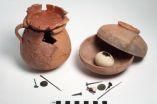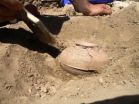(Press-News.org) MADISON, Wis. — By any measure, the ancient city of Sardis — home of the fabled King Croesus, a name synonymous with gold and vast wealth, and the city where coinage was invented — is an archaeological wonder.
The ruins of Sardis, in what is now Turkey, have been a rich source of knowledge about classical antiquity from the 7th century B.C., when the city was the capital of Lydia, through later Greek and Roman occupations.
Now, however, Sardis has given up another treasure in the form of two enigmatic ritual deposits, which are proving more difficult to fathom than the coins for which the city was famous.
"The two deposits each consist of a small pot with a lid, a coin, a group of sharp metal implements and an egg, one of which is intact except for a hole carefully punched in it in antiquity," explains Will Bruce, a classics graduate student a the University of Wisconsin-Madison who has been digging at Sardis for the past six years. Bruce made the finds last summer.
The dig at Sardis is overseen by Nicholas Cahill, a UW-Madison professor of art history. Cahill has directed field research at Sardis for decades. Both ritual deposits, says Cahill, date from the Roman era of Sardis, about A.D. 70 or 80.
Bruce and his team were excavating below the floor of a first century room, built over the ruins of an earlier building, which had probably been destroyed in a massive earthquake in A.D. 17.
Digging beneath the floor, Bruce and his colleagues first uncovered a thin-walled, nearly intact jug and, nearby, an assemblage of mostly unbroken pottery. "It looked like we were reaching a more intact deposit instead of fill," says Bruce.
Within that assemblage, Bruce began to carefully uncover an inverted bowl, which turned out to be sitting on top of another bowl. The bowls, still filled with dirt, were carefully removed and immediately turned over to conservators who cleaned and dissembled them to find a set of small pointed instruments, a coin with a lion and portrait of Nero, and the intact egg.
"The ritual offerings were dug into pits in the floor, after the room was constructed," says Cahill. "We know they were renovating the room periodically, because in another part of the space there was a dump of painted wall plaster buried under the floor, presumably in a renovation."
"The meaning of these deposits is still quite open to interpretation," notes Cahill, "but burying votive deposits below ground or in a wall was a fairly common practice," perhaps as a ritual offering to protect the house. Roman literary sources suggest eggs were used in particular rituals.
For the archaeologists, part of the intrigue is that similar groups of bowls, needles, coins and eggs were discovered at Sardis more than 100 years ago when the temple of Artemis was excavated by Princeton University archaeologists. "It is an exact parallel to what they found in the early 20th century," according to Cahill.
The coin was also unique. Sardis is famous as the place where coinage was invented in the Western world, first using electrum, an alloy of silver and gold, and later of pure gold and silver. Nearby sources of gold made ancient Lydia, and King Croesus, fabulously wealthy. While these Lydian coins are very rare, coins and coin hoards from later Greek and Roman occupiers of Sardis are routinely found.
But the coin found with the egg, says Cahill, seems to be special.
"The coin has a portrait of Nero on the front. The original reverse was hammered flat, and the image of a lion engraved in its place, which is very odd." Expert numismatists have never seen anything like it. "The image of the lion is important because it is emblematic of the Lydian kings and of their native mother goddess Cybele," Cahill says.
The discovery is unusual, Cahill notes, because finding ritualistic objects intact and in place after thousands of years is no everyday discovery, even in a rich archaeological context such as Sardis. "Ancient ritual was important to people. It is most unusual to find such fragile things so perfectly preserved."
INFORMATION:
Terry Devitt
608-262-8282
trdevitt@wisc.edu
Sardis dig yields enigmatic trove: Ritual egg in a pot
2014-03-04
ELSE PRESS RELEASES FROM THIS DATE:
World-class orchestras judged by sight not sound
2014-03-04
World-class orchestras can be accurately identified by silent video footage of performances, but not through sound recordings, a UCL study has found.
Both professional musicians and musical novices are better at identifying top-ranked orchestras from non-ranked orchestras when shown silent video footage, suggesting that such judgements are driven at least in part by visual cues about group dynamics and leadership.
When shown two 6-second clips, one from a world-class orchestra ranked among the top ten internationally - which included the London Symphony Orchestra, the ...
Plant extract offers hope for infant motor neurone therapy
2014-03-04
A chemical found in plants could reduce the symptoms of a rare muscle disease that leaves children with little or no control of their movements.
Scientists have found that a plant pigment called quercetin – found in some fruits, vegetables, herbs and grains – could help to prevent the damage to nerves associated with the childhood form of motor neuron disease.
Their findings could pave the way for new treatments for spinal muscular atrophy (SMA) – also known as floppy baby syndrome – which is a leading genetic cause of death in children.
The team has found that the ...
Yeast model reveals Alzheimer's drug candidate and its mechanism of action
2014-03-04
CAMBRIDGE, Mass. (March 3, 2014) – Using a yeast model of Alzheimer's disease (AD), Whitehead Institute researchers have identified a drug that reduces levels of the toxic protein fragment amyloid-β (Aβ) and prevents at least some of the cellular damage caused when Aβ accumulates in the brains of AD patients.
"We can use this yeast model to find small molecules that will address the underlying cellular pathologies of Alzheimer's, an age-related disease whose burden will become even more significant as our population grows older," says Kent Matlack, a former ...
Childhood adversity launches lifelong relationship and health disadvantages for black men
2014-03-04
AUSTIN, Texas — African American men who endured greater childhood adversity are likely to experience disadvantages in health and relationships over time, according to new sociology research from The University of Texas at Austin.
The study, published in the March issue of the Journal of Health and Social Behavior, helps to explain why African American men are less healthy than white men.
"Exposure to childhood adversity may cause stress and lead to a sequence of stressors over time that take a cumulative toll on relationships," says Debra Umberson, professor of sociology ...
Two studies examine bedroom TVs, active gaming and weight issues in children
2014-03-04
Bottom Line: Having a bedroom television is associated with weight gain in children and adolescents, and is unrelated to the time they spend watching.
Author: Diane Gilbert-Diamond, Sc.D., of the Geisel School of Medicine at Dartmouth, Lebanon, N.H., and colleagues.
Background: More than one-third of children and adolescents in the United States are overweight or obese. An estimated 71 percent of children and adolescents (ages 8 to 18 years) have bedroom televisions.
How the Study Was Conducted: The authors conducted a telephone survey in 2003 of 6,522 boys and girls ...
New research on potent HIV antibodies has opened up possibilities
2014-03-04
The discovery of how a KwaZulu-Natal woman's body responded to her HIV infection by making potent antibodies (called broadly neutralising antibodies, because they are able to kill multiple strains of HIV from across the world), was reported today by the CAPRISA consortium of AIDS researchers jointly with scientists from the United States.
The study, published in the prestigious scientific journal, Nature, describes how the research team found and identified these antibodies in her blood and then duplicated them by cloning the antibodies in the laboratory. The cloned antibodies ...
Distinctive flashing patterns might facilitate fish mating
2014-03-04
Scientists have shown for the first time that deep-sea fishes that use bioluminescence for communication are diversifying into different species faster than other glowing fishes that use light for camouflage. The new research indicates that bioluminescence—a phenomenon in which animals generate visible light through a chemical reaction—could promote communication and mating in the open ocean, an environment with few barriers to reproduction. The study was recently published in the journal Marine Biology.
"Bioluminescence is quite common in the deep sea, and many fishes ...
Quality of life improves with minimally invasive surgery for low back pain
2014-03-04
Beaumont research findings published in the February online issue of Spine shows that patients who have a low back surgery called minimally invasive transforaminal lumbar interbody fusion, end up better off in many ways than patients who have more invasive surgery to alleviate debilitating pain.
"About 90 percent of adults experience low back pain in their lifetime, which can be caused by spinal instability, stenosis, spondylolisthesis, and symptomatic degenerative disc disease," says Mick Perez-Cruet, M.D., neuro-spine surgeon at Beaumont Hospital, Royal Oak and professor, ...
Exercising during pregnancy reduces excessive weight gain and associated illnesses
2014-03-04
This news release is available in Spanish. Excessive weight gain during pregnancy increases the risk of suffering illnesses such as hypertension and gestational diabetes, or of having a premature birth or a birth by Caesarean; furthermore, it also has negative effects on the newly-born and increases the risk of infants being overweight by 30%.
Aware of the importance of preventing gestational weight gain, both in mother and child, researchers from the University of Granada, Madrid Polytechnic University and the European University carried out a study on the benefits ...
Opioid prescribing patterns examined in related research letter, study
2014-03-04
Bottom Line: Most people who use opioid painkillers without a physician's prescription initially get them from friends or relatives for free, but as the number of days of use increase sources for the medications expand to include prescriptions from physicians and purchases from friends, relatives, drug dealers or strangers.
Author: Christopher M. Jones, Pharm.D., M.P.H., who was with the National Center for Injury Prevention and Control, Centers for Disease Control and Prevention, Atlanta, at the time of research but is now with the U.S. Food and Drug Administration, ...





